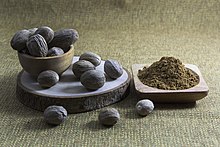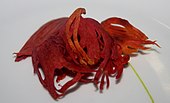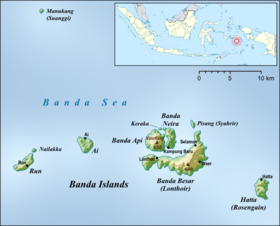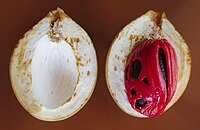Nutmeg
 | |
| Type | Seed and ground spice |
|---|---|
Nutmeg is the seed, or the ground spice derived from that seed, of several tree species of the genus Myristica;[1] fragrant nutmeg or true nutmeg (M. fragrans) is a dark-leaved evergreen tree cultivated for two spices derived from its fruit: nutmeg, from its seed, and mace, from the seed covering. It is also a commercial source of nutmeg essential oil and nutmeg butter. Indonesia is the main producer of nutmeg and mace, and the true nutmeg tree is native to its islands.
If consumed in amounts exceeding its typical use as a spice, nutmeg powder may produce
Conifers of the genus Torreya, commonly known as the nutmeg yews, have edible seeds of similar appearance, but are not closely related to M. fragrans, and are not used as a spice.
Common nutmeg
Nutmeg is the spice made by grinding the seed of the fragrant nutmeg tree (Myristica fragrans) into powder. The spice has a distinctive pungent fragrance and a warm, slightly sweet taste; it is used to flavor many kinds of baked goods, confections, puddings, potatoes, meats, sausages, sauces, vegetables, and such beverages as eggnog.[3]
The seeds are dried gradually in the sun over a period of 15 to 30 weeks. During this time, the nutmeg shrinks away from its hard seed coat until the kernels rattle in their shells when shaken. The shell is then broken with a wooden club and the nutmegs are picked out. Dried nutmegs are greenish brown ovoids with furrowed surfaces.[3] The nutmegs are roughly egg-shaped, about 20.5–30 mm (0.81–1.18 in) long and 15–18 mm (0.59–0.71 in) wide, weighing 5–10 g (0.18–0.35 oz) dried.
Two other species of genus Myristica with different flavors, M. malabarica and M. argentea, are sometimes used to adulterate nutmeg as a spice.[4]
Mace

Mace is the spice made from the reddish seed covering (aril) of the nutmeg seed. Its flavour is similar to that of nutmeg but more delicate; it is used to flavour baked goods, meat, fish, and vegetables, and in preserving and pickling.[5]
In the processing of mace, the crimson-colored aril is removed from the nutmeg seed that it envelops and is flattened out and dried for 10 to 14 days. Its color changes to pale yellow, orange, or tan. Whole dry mace consists of flat pieces—smooth, horn-like, and brittle—about 40 mm (1+1⁄2 in) long.[6]
Botany and cultivation

The most important commercial species is the common, true or fragrant nutmeg, M. fragrans (Myristicaceae), native to the Moluccas (or Spice Islands) of Indonesia.[7][8] It is also cultivated on Penang Island in Malaysia, in the Caribbean, especially in Grenada, and in Kerala, a state formerly known as Malabar in ancient writings as the hub of spice trading, in southern India. In the 17th-century work Hortus Botanicus Malabaricus, Hendrik van Rheede records that Indians learned the usage of nutmeg from the Indonesians through ancient trade routes.
Nutmeg trees are
The first harvest of nutmeg trees takes place 7–9 years after planting, and the trees reach full production after 20 years.
-
Nutmeg fruit
-
Red aril and seed within fruit
-
Aril surrounding nutmeg seed
Culinary uses

Spice
Nutmeg and mace have similar sensory qualities, with nutmeg having a slightly sweeter and mace a more delicate flavour. Mace is often preferred in light dishes for the bright orange, saffron-like hue it imparts. Nutmeg is used for flavouring many dishes. Whole nutmeg can also be ground at home using a grater specifically designed for nutmeg[9] or a multi-purpose grating tool.[10]
In
In
In traditional
Fruit

The
Essential oil
The essential oil obtained by
The oil is colorless or light yellow, and smells and tastes of nutmeg. It is used as a natural food flavoring in
Nutmeg butter
Nutmeg butter is obtained from the nut by expression. It is semisolid, reddish-brown in colour, and has the taste and smell of nutmeg itself.[13] About 75% (by weight) of nutmeg butter is trimyristin, which can be turned into myristic acid, a 14-carbon fatty acid, which can be used as a replacement for cocoa butter, can be mixed with other fats like cottonseed oil or palm oil, and has applications as an industrial lubricant.
History

The earliest evidence of use of nutmeg comes in the form of 3,500-year-old
In the sixth century AD, nutmeg use spread to India, then further west to Constantinople.[20] By the 13th century, Arab traders had pinpointed the origin of nutmeg to the Banda Islands, but kept this location a secret from European traders.[20]
Colonial era
The Banda Islands became the scene of the earliest European ventures in Asia, to get a grip on the spice trade. In August 1511,
In order to obtain a monopoly on the production and trade of nutmeg, the Dutch East India Company (VOC) waged a bloody battle with the Bandanese in 1621. Historian Willard Hanna estimated that before this struggle the islands were populated by approximately 15,000 people, and only 1,000 were left (the Bandanese were killed, starved while fleeing, exiled, or sold as slaves).[21] The Company constructed a comprehensive nutmeg plantation system on the islands during the 17th century.
As a result of the Dutch
Connecticut may have received its nickname ("the Nutmeg State", "Nutmegger") from the claim that some unscrupulous Connecticut traders would whittle "nutmeg" out of wood, creating a "wooden nutmeg", a term which later came to mean any type of fraud.[23][24] This narrative may have to do with the issue that one has to grate to obtain the spice powder, not crack a nutmeg, and this may not have been widely known by some purchasers of the product.[23]
Production
In 2019, global production of nutmeg was 142,000 tonnes, led by Indonesia, Guatemala, and India, having 38,000 to 43,000 tonnes each and a combined 85% of the world total.[25]
Psychoactivity and toxicity
Although used as a folk treatment for some ailments, nutmeg has no proven medicinal value.[2]
Effects
Ingested in small amounts as a spice, nutmeg produces no noticeable physiological or neurological response, but in large doses, both raw nutmeg freshly ground from kernels and
Varying considerably from person to person, nutmeg intoxication may occur with side effects, such as delirium, anxiety, confusion, headaches, nausea, dizziness, dry mouth, eye irritation, and amnesia.[2][16] Intoxication takes several hours to reach maximum effect,[2] and may last for several days.[16][26] Incidents of fatal poisoning from nutmeg and myristicin individually are uncommon.[2]
Nutmeg poisonings occur by accidental consumption in children and by intentional recreational use.[16] It is used recreationally with the intention of achieving a low-cost high resembling psychedelics, particularly by adolescents, drug users, college students, and prisoners.[28] Relatively large doses of nutmeg are required to produce effects; a majority of reported nutmeg intoxication cases appear to result from recreational use.[29]
Toxicity during pregnancy
Nutmeg was once considered an abortifacient, but may be safe during pregnancy if used only in flavoring amounts.[2] If consumed in large amounts, nutmeg could cause premature labor and miscarriage. Nutmeg may also interact with pain relievers such as pethidine, so avoiding it during pregnancy is recommended.[30]
Toxicity to pets
The scent of nutmeg may attract pets, but it can be poisonous if consumed in excess.[31]
References
- ^ "Nutmeg and derivatives (Review)". Food and Agriculture Organization (FAO) of the United Nations. September 1994. Archived from the original on 30 October 2018. Retrieved 29 October 2018.
- ^ a b c d e f g h i j k "Nutmeg". Drugs.com. 2009. Archived from the original on 2020-12-16. Retrieved 2017-05-04.
- ^ a b "Nutmeg spice". Encyclopædia Britannica Online.
- ^ "Nutmeg". www.clovegarden.com. Archived from the original on 2017-02-18. Retrieved 2017-07-22.
- ISBN 978-1439856864. Archivedfrom the original on 2023-06-30. Retrieved 2019-08-27.
- ^ "Mace spice". Encyclopædia Britannica Online.
- New York Times. Archivedfrom the original on September 11, 2019. Retrieved April 13, 2017.
- ^ Dotschkal, Janna (2015-06-22). "The Spice Trade's Forgotten Island". National Geographic. Archived from the original on 2016-12-13. Retrieved 2017-04-13.
- ^ Oulton, Randal (18 February 2007). "Nutmeg Graters". CooksInfo.com. Archived from the original on 10 January 2018. Retrieved 8 April 2018.
- ^ Barber, Casey (18 February 2007). "Do you really need a Microplane for your kitchen? Yes, and here's why". today.com. Archived from the original on 8 November 2019. Retrieved 8 November 2019.
- ISBN 978-0-544-17738-3.
- ^ ISBN 978-1-84537-619-2.
- ^ a b c "Description of components of nutmeg". Food and Agriculture Organization of the United Nations. September 1994. Archived from the original on 2017-05-29. Retrieved 2017-04-13.
- PMID 28082856.
- PMID 22429024.
- ^ PMID 24452991.
- ISBN 9781784770624. Archivedfrom the original on 2023-06-30. Retrieved 2020-10-06.
- S2CID 165484454.
- ^ "Mryristicin - - Molecule of the Month - August 2014 (HTML version)". www.chm.bris.ac.uk. Archived from the original on 2022-10-06. Retrieved 2022-04-28.
- ^ ISBN 0415927463.
- ^ Hanna, Willard (1991). Indonesian Banda: Colonialism and Its Aftermath in the Nutmeg Islands. Moluccas, East Indonesia: Yayasan Warisan dan Budaya Banda Neira.
- ISBN 0-340-69675-3
- ^ a b Rebecca Furer (12 August 2011). "What is a Nutmegger?". Connecticut Public Radio. Archived from the original on 29 October 2018. Retrieved 29 October 2018.
- ^ "Nicknames for Connecticut". Connecticut State Library. 2018. Archived from the original on 1 September 2015. Retrieved 29 October 2018.
- ^ "World production of nutmeg, mace and cardamoms in 2019; Crops/Regions/World/Production Quantity from pick lists". Food and Agriculture Organization of the United Nations, Statistics Division (FAOSTAT). 2019. Archived from the original on 12 November 2016. Retrieved 12 February 2021.
- ^ a b c
Demetriades, A. K.; Wallman, P. D.; McGuiness, A.; Gavalas, M. C. (2005). "Low Cost, High Risk: Accidental Nutmeg Intoxication". Emergency Medicine Journal. 22 (3): 223–225. PMID 15735280.
- S2CID 21133983.
- .
- S2CID 6839715.
- ^ "Herb and drug safety chart". BabyCentre UK. 2018. Archived from the original on 15 October 2012. Retrieved 29 October 2018.
- ^ Charlotte Flint (2018). "Nutmeg Toxicity". Pet Poison Helpline. Archived from the original on 30 October 2018. Retrieved 29 October 2018.
External links
 Media related to Nutmegs at Wikimedia Commons
Media related to Nutmegs at Wikimedia Commons Data related to Myristica fragrans at Wikispecies
Data related to Myristica fragrans at Wikispecies



